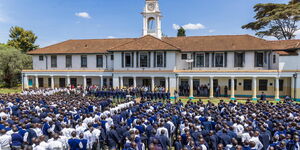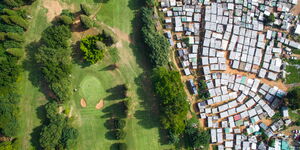The story of one of Nairobi's popular streets and one of the oldest Masonic buildings with a unique name acquired from Malawi is credited to an explorer who dropped out of school to pursue other interests in life.
Ewart Scott Grogan's enrollment to Winchester and Jesus colleges in the United Kingdom did not last as he was expelled from both institutions for various reasons.
Following his expulsions, Grogan spent most of his time learning art and later moved to Bulawayo, Zimbabwe.
But it is his story in Nairobi that stands out. It was a story of love and affection. While in his usual travels, Grogan decided to volunteer as a soldier during the Matabele uprising in 1896. He would later be injured in the battlefield, with the injury forcing him to retire to New Zealand to recuperate.
It was during the recuperation period that he met the love of his life, Gertrude Watt. He easily won her heart with his tales of triumph on the battlefield. However, his folktales did not convince his would be father-in-law who dismissed him as a useless fortune hunter.
But to win Gertrude's heart and convince his father-in-law, Grogan embarked on an adventurous journey. At the age of 24, he pulled a historical stunt by walking from Cape Town in South Africa to Cairo in Egypt. However, no documentation is available showing his route map and travel itinerary.
To receive a blessing in marriage, Grogan took two years on his journey from Cape Town to Cairo. While traveling back to Cape Town, he passed by Nairobi but he was not impressed.
While on his journey, the explorer met Cecil Rhodes, a renowned businessman whom Zimbabwe was named after and invited him to settle in South Africa.
However, South Africa was not favourable to him. When he saw an advert calling for settlers to East Africa, he decided to move to Kenya and bought land in the famous Mau escarpment and set up a timber business.
His land, 113 acres in size, bordered rivers Nairobi and Kitrichwa. He acquired the services of London-based architect, Graswell, and local Indian contractors to build him the house in 1905.
In Nairobi, Grogan was impressed by the weather in Chiromo and bought land there. At the time, the place was not named Chiromo and he gave it that name, a name he borrowed from a village in southern Zimbabwe where he had lost his luggage.
With the art skills he gained after dropping out of school, Grogan built the first stone house which stands at the Institute of Computer Science (ICS), which is part of the University of Nairobi's Chiromo Campus.
The building stood out with Masonic symbols such as the occult's evil eye and two feline idols indicating it was a Templar lodge.
Grogan did not own the Chiromo stone house for long. In 1910, he sold the house to an American millionaire and invested the money in other parts of Westlands.
During his businesses ventures, the explorer acquired land which was named after him. A road passing through the land was later named Grogan Roundabout and is the present day Kirinyaga Road.
In 1947, out of his love for children and families, Grogan purchased the land on which Gertrude's Garden Children's Hospital stands. He is credited as the founder of the hospital having started it in memory of his wife, Gertrude Watt.
His legacy lives on and is best told through Chiromo and Gertrude's Children Hospital which has over seven branches in Nairobi.












